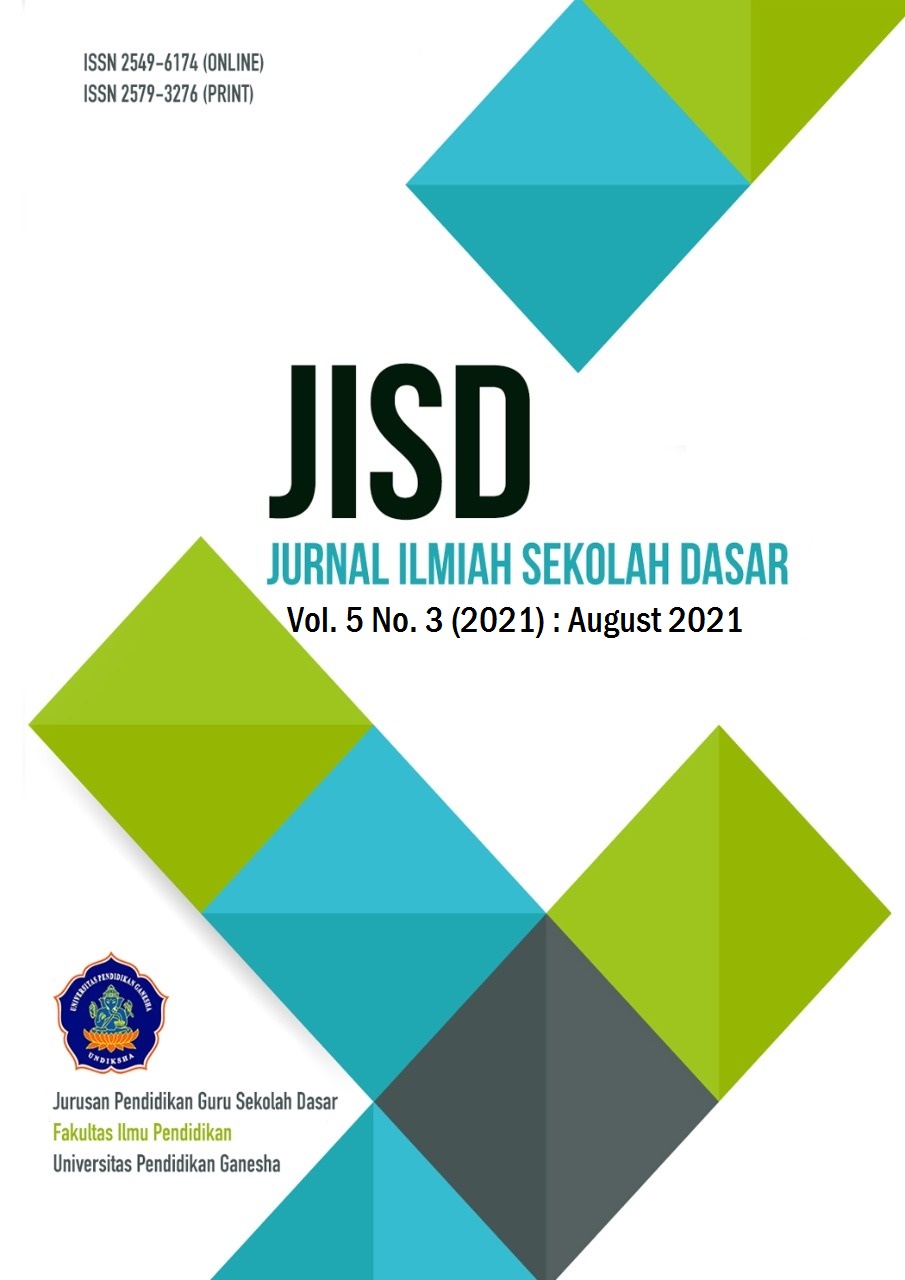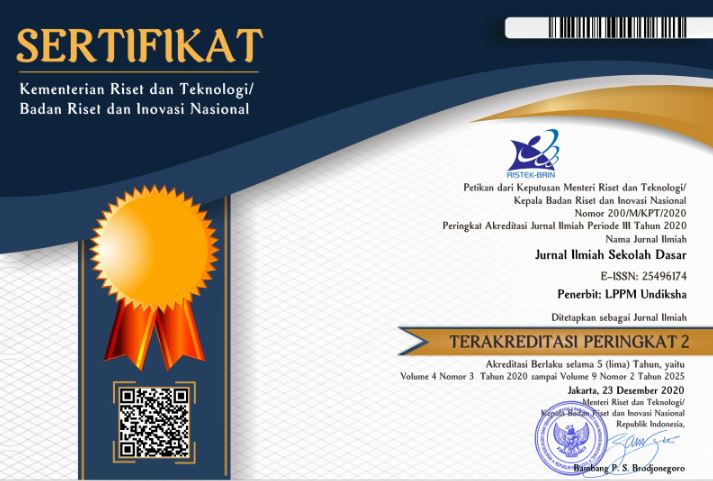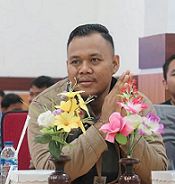Online Learning Based on Realistic Mathematic Education (RME) Assisted Animation Media in Improving Student Learning Outcomes
DOI:
https://doi.org/10.23887/jisd.v5i3.39716Keywords:
Realistic Mathematical Education, Learning OutcomesAbstract
There are still many teachers who have difficulty determining appropriate learning methods and learning media for mathematics lessons. This has an impact on student learning outcomes are low. This study aims to analyze the effect of the Realistic Mathematical Education (RME) approach assisted by animation media on students' mathematics learning outcomes. This research is a quantitative research with a quasi-experimental research design with a non-equivalent control group design research design. This study involved 30 students as the research sample with a simple random sampling technique (Simple Random Sampling). This study uses data collection techniques, namely observation and written tests by giving five essay questions with different weights for each question. The data obtained were analyzed using the SPSS v.22 application by looking for the results of the normality test, homogeneity test, N-Gain test and finally the t-test (Independent Sample Test) to test the hypothesis. The results showed that there was a difference between the students' average scores by applying the Realistic Mathematical Education (RME) approach with the aid of animation media, obtaining an average score of 74.60 in the medium category. Based on the results of data analysis, there is a significant effect on mathematics learning outcomes which can be proven from the significance value at the output of the Independent Sample Test, namely 0.000 < 0.05, which means that H0 is rejected and Ha is accepted. It can be concluded that the Realistic Mathematical Education (RME) approach assisted by animation media can improve mathematics learning outcomes.
References
Abramovitz, B., Berezina, M., Berman, A., & Shvartsman, L. (2012). A Blended Learning Approach in Mathematics. Teaching Mathematics Online: Emergent Technologies and Methodologies, 21. https://doi.org/10.4018/978-1-60960-875-0.ch002. DOI: https://doi.org/10.4018/978-1-60960-875-0.ch002
Andhika, I. M. E., Suardika, W. R., & Wiyasa, I. K. N. (2013). Pengaruh Model Pembelajaran Kooperatif Tipe Inside Outside Circle Berbasis Media Audio Visual Animation Terhadap Hasil Belajar IPS. Mimbar PGSD Undiksha, 1(1). https://doi.org/10.23887/jjpgsd.v1i1.950.
Arsaythamby, V., & Zubainur, C. M. (2014). How a Realistic Mathematics Educational Approach Affect Students’ Activities in Primary Schools? Procedia - Social and Behavioral Sciences, 159. https://doi.org/10.1016/j.sbspro.2014.12.378. DOI: https://doi.org/10.1016/j.sbspro.2014.12.378
Baya’a, N., Daher, W., & Anabousy, A. (2019). The development of in-service mathematics teachers’ integration of ICT in a community of practice: Teaching-in-context theory. International Journal of Emerging Technologies in Learning, 14(1), 125–139. https://doi.org/10.3991/ijet.v14i01.9134. DOI: https://doi.org/10.3991/ijet.v14i01.9134
Bosica, J., S.Pyper, J., & MacGregor, S. (2021). Incorporating problem-based learning in a secondary school mathematics preservice teacher education course. Teaching and Teacher Education, 102, 103335. https://doi.org/10.1016/j.tate.2021.103335. DOI: https://doi.org/10.1016/j.tate.2021.103335
Bustanil S, M., Asrowi, & Adianto, D. T. (2019). Pengembangan Media Pembelajaran Interaktif Berbasis Video Tutorial Di Sekolah Menengah Kejuruan. JTP - Jurnal Teknologi Pendidikan, 21(2), 119–134. https://doi.org/10.21009/jtp.v21i2.11568. DOI: https://doi.org/10.21009/jtp.v21i2.11568
Cimen, O. A. (2014). Discussing Ethnomathematics: Is Mathematics Culturally Dependent? Procedia - Social and Behavioral Sciences, 152. https://doi.org/10.1016/j.sbspro.2014.09.215. DOI: https://doi.org/10.1016/j.sbspro.2014.09.215
Dinayusadewi, N. P., Ngurah, G., & Agustika, S. (2020). Development Of Augmented Reality Application As A Mathematics Learning Media In Elementary School Geometry Materials. Journal of Education Technology, 4(2), 204–210. https://doi.org/10.23887/jet.v4i2.25372. DOI: https://doi.org/10.23887/jet.v4i2.25372
Dooren, W. Van, Lem, S., Wortelaer, H. De, & Verschaffel, L. (2019). Improving realistic word problem solving by using humorTitle. The Journal of Mathematical Behavior, 53. https://doi.org/10.1016/j.jmathb.2018.06.008. DOI: https://doi.org/10.1016/j.jmathb.2018.06.008
Faidah, N., Masykur, R., Andriani, S., & Lina Herlina. (2019). Realistic Mathematics Education ( Rme ) Sebagai Sebuah Pendekatan Pada Pengembangan Modul Matematika Berbasis Teori Multiple Intelligences Realistic Mathematics Education ( Rme ) As an Approach To Development of Mathematical Module Based on Multiple Intel. Indonesia Journal of Science and Mathematics Education, 02(3), 328–332. https://doi.org/10.24042/ijsme.v2i3.4396. DOI: https://doi.org/10.24042/ijsme.v2i3.4396
Fatah, A., Suryadi, D., Sabandar, J., & Turmudi. (2016). Open-Ended Approach: An Effort In Cultivating Students’ Mathematical Creative Thinking Ability And Self-Esteem In Mathematics. Journal on Mathematics Education, 7(1), 9–18. https://doi.org/10.22342/jme.7.1.2813.9-18. DOI: https://doi.org/10.22342/jme.7.1.2813.9-18
Gunawan, G., Sahidu, H., Harjono, A., & Suranti, N. M. Y. (2017). The effect of project based learning with virtual media assistance on student’s creativity in physics. Jurnal Cakrawala Pendidikan, 2. https://doi.org/10.21831/cp.v36i2.13514. DOI: https://doi.org/10.21831/cp.v36i2.13514
Hafidzah, N. A., Azis, Z., & Irvan, I. (2019). The Effect of Open Ended Approach on Problem Solving Ability and Learning Independence in Students’ Mathematics Lessons. Indonesia Journal of Education & Mathematics Science, 1(2), 105–110. https://doi.org/10.30596%2Fijems.v2i1.6176.
Hanif, M. (2020). The development and effectiveness of motion graphic animation videos to improve primary school students’ sciences learning outcomes. International Journal of Instruction, 13(4), 247–266. https://doi.org/10.29333/iji.2020.13416a. DOI: https://doi.org/10.29333/iji.2020.13416a
Hassan, S. R., Rosli, R., & Zakaria, E. (2016). The Use of i-Think Map and Questioning to Promote Higher-Order Thinking Skills in Mathematics. Creative Education, 07(07), 1069–1078. https://doi.org/10.4236/ce.2016.77111. DOI: https://doi.org/10.4236/ce.2016.77111
Hidayat, E. I. F., Vivi Yandhari, I. A., & Alamsyah, T. P. (2020). Efektivitas Pendekatan Realistic Mathematics Education (RME) Untuk Meningkatkan Kemampuan Pemahaman Konsep Matematika Siswa Kelas V. Jurnal Ilmiah Sekolah Dasar, 4(1), 106. https://doi.org/10.23887/jisd.v4i1.21103. DOI: https://doi.org/10.23887/jisd.v4i1.21103
Hwang, G. J., Wang, S. Y., & Lai, C. L. (2020). Effects of a social regulation-based online learning framework on students’ learning achievements and behaviors in mathematics. Computers and Education, 160, 104031. https://doi.org/10.1016/j.compedu.2020.104031. DOI: https://doi.org/10.1016/j.compedu.2020.104031
Jailani. (2017). Penggunaan Peta Konsep Untuk Belajar Bermakna Dan Peningkatan Pemahaman Siswa dalam Pembelajaran Biologi. Jurnal Biology Education, 6(1), 30–40. https://doi.org/10.1017/CBO9781107415324.004. DOI: https://doi.org/10.1017/CBO9781107415324.004
Japa, N., Suarjana, I. M., & Widiana, W. (2017). Media Geogebra Dalam Pembelajaran Matematika. International Journal of Natural Science and Engineering, 1(2), 40–47. https://doi.org/10.23887/IJNSE.V1I2.12467. DOI: https://doi.org/10.23887/ijnse.v1i2.12467
Jeheman, A. A., Gunur, B., & Jelatu, S. (2019). Pengaruh Pendekatan Matematika Realistik terhadap Pemahaman Konsep Matematika Siswa. Mosharafa: Jurnal Pendidikan Matematika, 8(2), 191–202. https://doi.org/10.31980/mosharafa.v8i2.454. DOI: https://doi.org/10.31980/mosharafa.v8i2.454
Kartika, Y., Wahyuni, R., Sinaga, B., & Rajagukguk, J. (2019). Improving Math Creative Thinking Ability by using Math Adventure Educational Game as an Interactive Media. Journal of Physics: Conference Series, 1179(1), 1–6. https://doi.org/10.1088/1742-6596/1179/1/012078. DOI: https://doi.org/10.1088/1742-6596/1179/1/012078
Kühl, T. (2021). Prerequisite knowledge and time of testing in learning with animations and static pictures: Evidence for the expertise reversal effect. Learning and Instruction, 73. https://doi.org/10.1016/j.learninstruc.2021.101457. DOI: https://doi.org/10.1016/j.learninstruc.2021.101457
Lin, L., & Li, M. (2018). Optimizing learning from animation: Examining the impact of biofeedback. Learning and Instruction, 55. https://doi.org/10.1016/j.learninstruc.2018.02.005. DOI: https://doi.org/10.1016/j.learninstruc.2018.02.005
Lin, S., Zhou, Y., & Wijaya, T. T. (2020). Using hawgent dynamic mathematics software in teaching arithmetic operation. International Journal of Education and Learning, 2(1), 25–31. https://doi.org/10.31763/ijele.v2i1.97. DOI: https://doi.org/10.31763/ijele.v2i1.97
Lukman, A., Hayati, D. K., & Hakim, N. (2019). Pengembangan Video Animasi Berbasis Kearifan Lokal pada Pembelajaran IPA Kelas V di Sekolah Dasar. Elementary: Jurnal Ilmiah Pendidikan Dasar, 5(2), 153. https://doi.org/10.32332/elementary.v5i2.1750. DOI: https://doi.org/10.32332/elementary.v5i2.1750
Mailizar, M., Almanthari, A., Maulina, S., & Bruce, S. (2020). Secondary School Mathematics Teachers’ Views on E-learning Implementation Barriers during the COVID-19 Pandemic: The Case of Indonesia. Eurasia Journal of Mathematics, Science and Technology Education, 16(7), em1860. https://doi.org/10.29333/ejmste/8240. DOI: https://doi.org/10.29333/ejmste/8240
Margareta, L., & Wahyuno, E. (2014). Penggunaan Media Animasi Macromedia Flash Untuk Meningkatkan Kualitas Pembelajaran Ipa Siswa Tunarungu Kelas II SDLB. Jurnal P3Lb, 1(2), 137–139. https://doi.org/10.17977/um029v1i22014p137-139.
Mullis, I. V., Martin, M. O., Minnich, C. A., Stanco, G. M., Arora, A., Centurino, V. A., & Castle, C. E. (2012). Encyclopedia: Education Policy and Curriculum in Mathematics and Science. In Pirls (Vol. 1). https://doi.org/10.6209/JORIES.2017.62(1).03.
Muslina, M., Halim, A., & Khaldun, I. (2018). Kelayakan Media Animasi Hukum Newton Ii Tentang Gerak Pada Bidang Miring Dan Katrol Di Sma Kabupaten Aceh Besar. Jurnal IPA & Pembelajaran IPA, 1(1), 64–72. https://doi.org/10.24815/jipi.v1i1.9568. DOI: https://doi.org/10.24815/jipi.v1i1.9568
Noviyanto, T. S. H., Juanengsih, N., & Rosyidatun, E. S. (2015). Penggunaan Media Video Animasi Sistem Pernapasan Manusia Untuk Meningkatkan Hasil Belajar Biologi. Edusains, 7(1), 57–63. https://doi.org/10.15408/es.v7i1.1215. DOI: https://doi.org/10.15408/es.v7i1.1215
Prasetyo, G., Hidayatullah, M. F., Akhyar, M., Wiranto, & Perdana, R. (2020). Strengthening Students’ Character Through Multimedia Learning In Primary Schools Education: Systematic LiteraturPrasetyo, G., Hidayatullah, M. F., Akhyar, M., Wiranto, & Perdana, R. (2020). Strengthening Students’ Character Through Multimedia Learning In . Humanities & Social Sciences Reviews, 8(3), 268–277. https://doi.org/10.18510/hssr.2020.8328. DOI: https://doi.org/10.18510/hssr.2020.8328
Rahayuningsih, S. (2020). Animation media of animal husbandry thematic science learning to stimulate scientific attitude in early childhood. International Journal of Scientific and Technology Research. https://doi.org/10.23887/jet.v3i1.17959 Article Metrics. DOI: https://doi.org/10.23887/jet.v3i1.17959
Rajagukguk, & Simanjuntak. (2015). Problem-Based Mathematics Teaching Kitsintegrated With ICT To Improvestudents’ Critical Thinking Ability Injunior High Schools In Medan. Cakrawala Pendidikan, 34(3). https://doi.org/10.21831/cp.v3i3.7342. DOI: https://doi.org/10.21831/cp.v3i3.7342
Riyanto, W. D., & Gunarhadi, G. (2017). The Effectiveness of Interactive Multimedia in Mathematic Learning: Utilizing Power Points for Students with Learning Disability. IJPTE : International Journal of Pedagogy and Teacher Education, 1(1), 55–63. https://doi.org/10.20961/ijpte.v1i1.8400. DOI: https://doi.org/10.20961/ijpte.v1i1.8400
Saripudin, E, Sari, I., & Mukhtar, M. (2018). Using Macro Flash Animation Media on Motion Material to Improve Learning Achievement for Learning Science in Junior High School. , 4 (1),. Journal of Science Research and Learning, 4(1), 68–75. https://doi.org/10.30870/jppi.v4i1.3316.
Saripudin, Endang, Sari, I. J., & Mukhtar, M. (2018). Using Macro Flash Animation Media on Motion Material to Improve Learning Achievement for Learning Science in Junior High School. Jurnal Penelitian Dan Pembelajaran IPA, 4(1), 68–75. https://doi.org/10.30870/jppi.v4i1.3316. DOI: https://doi.org/10.30870/jppi.v4i1.3316
Satyawan, V. (2018). The Use Of Animation Video To Teach English At Junior High School Students. Jellt (Journal of English Language and Language Teaching), 2(2), 89–96. https://doi.org/10.36597/jellt.v2i2.3277. DOI: https://doi.org/10.36597/jellt.v2i2.3277
Schoenfeld, A. H. (2016). Learning to Think Mathematically: Problem Solving, Metacognition, and Sense Making in Mathematics (Reprint). Journal of Education. https://doi.org/10.1177/002205741619600202. DOI: https://doi.org/10.1177/002205741619600202
Setiawan, I. M. D., & Ari Oka, I. D. G. (2020). The Use of Audio-Visual Assisted Google Classroom for Mathematics Course. Journal of Education Technology, 4(3), 244. https://doi.org/10.23887/jet.v4i3.28529. DOI: https://doi.org/10.23887/jet.v4i3.28529
Setyowati, N., & Mawardi. (2018). Sinergi Project Based Learning dan Pembelajaran Bermakna Untuk Meningkatkan Hasil Belajar Matematika. Scholaria, 8(3), 253–263. https://doi.org/10.24246/j.js.2018.v8.i3.p253-263. DOI: https://doi.org/10.24246/j.js.2018.v8.i3.p253-263
Sitorus, J., & Masrayati. (2016). Students’ creative thinking process stages: Implementation of realistic mathematics education. Thinking Skills and Creativity, 22. https://doi.org/10.1016/j.tsc.2016.09.007. DOI: https://doi.org/10.1016/j.tsc.2016.09.007
Sulastri, S., & Kusmanto, B. (2016). Upaya Meningkatkan Motivasi Dan Prestasi Belajar Matematika Melalui Model Rme (Realistic Mathematics Education) Siswa Kelas Ix a Smp Negeri 04 Bumiayu Semerter 1 Tahun Pelajaran 2013/2014. UNION: Jurnal Ilmiah Pendidikan Matematika, 4(3), 435–444. https://doi.org/10.30738/.v4i3.443. DOI: https://doi.org/10.30738/.v4i3.443
Sumirattana, S., Siriporn, M., & Thipkongc, A. (2017). Using realistic mathematics education and the DAPIC problem-solving process to enhance secondary school students’ mathematical literacy. Kasetsart Journal of Social Sciences, 8(3). https://doi.org/10.1016/j.kjss.2016.06.001. DOI: https://doi.org/10.1016/j.kjss.2016.06.001
Wahyuni, D. (2019). Pengembangan Multimedia Pembelajaran Matematika Dengan Pendekatan Matematika Realistik. AKSIOMA: Jurnal Program Studi Pendidikan Matematika, 8(1), 32–40. https://doi.org/10.24127/ajpm.v8i1.1711. DOI: https://doi.org/10.24127/ajpm.v8i1.1711
Waziri, M. ., Saidu, I., & Musa, H. (2010). A Mathematical Approach on Solving Hausa Puzzles in Northern Nigeria. Procedia - Social and Behavioral Sciences, 8. https://doi.org/10.1016/j.sbspro.2010.12.096. DOI: https://doi.org/10.1016/j.sbspro.2010.12.096
Yamashita, S., Yeo, J., Nakanishi, K., Kojima, K., Igarashi, R., Terasawa, A., Chang, J., Toh, J., Pang, A., Ashardianto, S., & Nomura, J. (2019). Development and Evaluation of Global Positioning System Science Lesson Based on Science, Technology, Engineering, and Mathematics Model in Singapore. Science Education International, 30(3), 194–199. https://doi.org/10.33828/sei.v30.i3.5. DOI: https://doi.org/10.33828/sei.v30.i3.5
Yuliani, H. (2017). Pembelajaran Fisika menggunakan Media Animasi Macromedia Flash-MX dan Gambar untuk Meningkatkan Pemahaman Konsep Mahasiswa. Jurnal Ilmiah Pendidikan Fisika Al-Biruni, 6(1), 13–21. https://doi.org/10.24042/jpifalbiruni.v6i1.596. DOI: https://doi.org/10.24042/jpifalbiruni.v6i1.596
Zandieh, M., & Rasmussen, C. (2010). Defining as a mathematical activity: A framework for characterizing progress from informal to more formal ways of reasoning. The Journal of Mathematical Behavior, 29(2). https://doi.org/10.1016/j.jmathb.2010.01.001. DOI: https://doi.org/10.1016/j.jmathb.2010.01.001
Zhang, J., Liao, G., & Li, N. (2020). Combining active learning and local patch alignment for data-driven facial animation with fine-grained local detail. Neurocomputing, 39. https://doi.org/10.1016/j.neucom.2019.05.102. DOI: https://doi.org/10.1016/j.neucom.2019.05.102
Downloads
Published
How to Cite
Issue
Section
License
Authors who publish with the Journal Ilmiah Sekolah Dasar agree to the following terms:
- Authors retain copyright and grant the journal the right of first publication with the work simultaneously licensed under a Creative Commons Attribution License (CC BY-SA 4.0) that allows others to share the work with an acknowledgment of the work's authorship and initial publication in this journal.
- Authors are able to enter into separate, additional contractual arrangements for the non-exclusive distribution of the journal's published version of the work (e.g., post it to an institutional repository or publish it in a book), with an acknowledgment of its initial publication in this journal.
- Authors are permitted and encouraged to post their work online (e.g., in institutional repositories or on their website) prior to and during the submission process, as it can lead to productive exchanges, as well as earlier and greater citation of published work. (See The Effect of Open Access)










